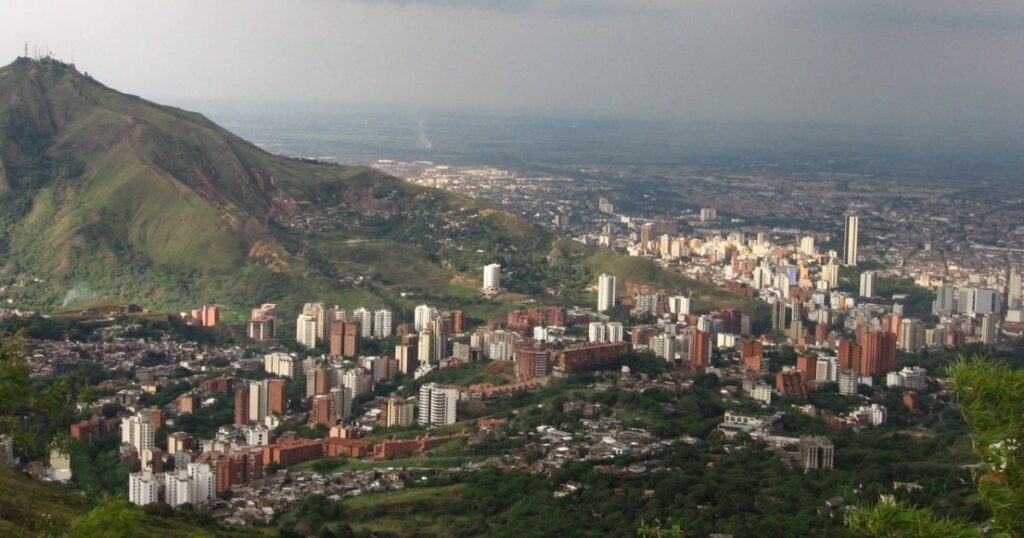Cali, officially known as Santiago de Cali, is a vibrant city located in the southwestern part of Colombia. As the capital of the Valle del Cauca department and the third-largest city in the country, Cali carries a rich cultural heritage, thriving economy, and stunning natural beauty. In this detailed guide, we explore everything you need to know about Cali, Colombia.

Geography and Climate of Cali, Colombia
Location and Topography
Cali is strategically nestled in the Valle del Cauca region, surrounded by the majestic Andes Mountains. The city sits approximately 1,000 meters (3,281 feet) above sea level in a fertile valley carved by the Cauca River, providing a lush and verdant landscape that is both picturesque and agriculturally productive.

Climate
Cali enjoys a tropical savanna climate, characterized by warm temperatures throughout the year. The average annual temperature hovers around 26°C (79°F), with slight variations between day and night. The city experiences two distinct rainy seasons: from March to May and from September to November, while the dry seasons span December to February and June to August. This climate ensures that Cali remains green and vibrant year-round.
Historical Significance
Colonial Foundations
Founded on July 25, 1536, by Spanish conquistador Sebastián de Belalcázar, Cali has a storied past that reflects its importance during the colonial era. As one of the earliest Spanish settlements in the region, Cali played a crucial role in the exploration and colonization of Colombia.
Path to Independence
Cali was instrumental in Colombia’s fight for independence from Spanish rule. The city declared its independence on July 3, 1810, becoming a key battleground and a symbol of resistance during the struggle for freedom. This rich historical backdrop adds depth to Cali’s cultural identity.
Modern Development
Throughout the 20th century, Cali experienced significant industrial growth and urbanization. The city’s expansion was driven by its strategic location and fertile lands, making it an economic powerhouse in Colombia. Today, Cali is a dynamic metropolis that continues to evolve and thrive.
Cultural Richness
Salsa Capital of the World
Cali is globally renowned as the “Salsa Capital of the World.” The city’s deep-rooted passion for salsa dancing is evident in its numerous dance schools, lively clubs, and vibrant festivals. The annual World Salsa Festival, held in Cali, attracts dancers and enthusiasts from around the globe, showcasing the city’s unique dance style and infectious rhythm.
Festivals and Celebrations
Cali hosts a variety of cultural festivals that highlight its diverse heritage. The Feria de Cali, held every December, is a major event featuring parades, concerts, bullfights, and traditional celebrations. Another notable festival is the Petronio Álvarez Festival, which celebrates Afro-Colombian music and culture, emphasizing Cali’s multicultural roots.

Culinary Delights
Cali’s cuisine is a delightful fusion of indigenous, Spanish, and African influences. Popular dishes include sancocho de gallina (chicken stew), arroz atollado (sticky rice with meat), and aborrajados (fried plantains with cheese). The city’s food scene offers a tantalizing array of flavors that reflect its rich cultural tapestry.
Economic Powerhouse
Industrial Hub
Cali stands as a key industrial hub in Colombia, with thriving sectors in sugar production, food processing, textiles, and chemicals. The Valle del Cauca region is renowned for its extensive sugarcane plantations, making it one of the top sugar-producing areas globally. This industrial prowess is a cornerstone of Cali’s economy.
Agricultural Riches
The fertile lands surrounding Cali support diverse agricultural activities. The region is famous for its high-quality coffee, sugar, fruits, and flowers. Additionally, cattle ranching plays a significant role in the local economy, contributing to the city’s agricultural output.
Business and Commerce
Cali’s strategic location and developed infrastructure make it an attractive destination for multinational companies. The city’s business environment is conducive to growth, with numerous opportunities in various sectors, including finance, trade, and technology.
Educational and Research Excellence
Top Universities
Cali is home to several prestigious universities that contribute to its reputation as an educational center. The Universidad del Valle is renowned for its strong programs in engineering and health sciences, while the Pontificia Universidad Javeriana Cali stands out as a leading private institution offering a wide range of academic disciplines.
Research Institutions
The city boasts numerous research institutions focusing on diverse fields such as agriculture, biotechnology, and medical sciences. The International Center for Tropical Agriculture (CIAT) is a prominent research organization based in Cali, driving innovation and sustainable practices in tropical agriculture.
Tourist Attractions
Historic Neighborhoods
Cali’s historic neighborhoods, such as San Antonio and La Merced, offer a glimpse into the city’s colonial past. These areas feature charming streets, colonial architecture, and cultural landmarks like the Church of San Antonio and the La Merced Archaeological Museum.

Modern Landmarks
Modern attractions in Cali include the Cali Zoo, renowned as one of the best in Latin America, and the towering Cristo Rey statue, which provides panoramic views of the city. The bustling Cali Tower is another popular landmark that symbolizes the city’s urban growth.
Natural Beauty
The nearby Farallones de Cali National Park is a haven for nature lovers, offering opportunities for hiking, bird watching, and exploring diverse ecosystems. The region’s coffee plantations and sugarcane fields also provide scenic beauty and a taste of local culture.
Infrastructure and Development
Transportation Network
Cali boasts an efficient transportation network that facilitates easy movement within and beyond the city. The Alfonso Bonilla Aragón International Airport connects Cali to major Colombian and international destinations. The city’s public transit system, including the MIO (Masivo Integrado de Occidente), enhances accessibility and convenience for residents and visitors alike.
Urban Planning
Recent investments in urban infrastructure have transformed Cali into a modern city with improved road networks, public spaces, and housing developments. The city’s urban planning initiatives focus on sustainability and enhancing the quality of life for its inhabitants.
Sports and Recreation
Football (Soccer) Enthusiasm
Football is a beloved sport in Cali, with the city hosting two major professional teams: Deportivo Cali and América de Cali. These teams have passionate fan bases and storied histories, contributing to the vibrant football culture in the city.
Other Sports Activities
Cali also promotes a range of other sports, including basketball, volleyball, and athletics. The Pascual Guerrero Stadium is a key venue that hosts various sporting events and concerts, serving as a hub for recreational activities.
Healthcare and Safety
Healthcare Facilities
Cali’s healthcare system is robust, featuring several major hospitals and clinics, such as the Fundación Valle del Lili and Hospital Universitario del Valle. The city is a center for medical research and healthcare services, providing high-quality care to residents and visitors.
Safety Measures
While Cali has faced challenges with crime, particularly related to drug trafficking, significant strides have been made to improve public safety. Local authorities continue to implement measures to enhance security and promote community well-being, making Cali a safer place to live and visit.
Environmental Sustainability
Green Initiatives
Cali is committed to sustainability, with initiatives aimed at reducing pollution, enhancing public transportation, and increasing green spaces. The city promotes recycling and waste management programs to foster environmental responsibility.
Biodiversity Conservation
The areas surrounding Cali are rich in biodiversity, featuring a variety of flora and fauna. Efforts are ongoing to preserve these natural habitats and promote eco-tourism, ensuring the conservation of the region’s unique ecosystems.
Cali, with its dynamic culture, economic significance, and natural beauty, continues to be a vital and vibrant part of Colombia. Its unique blend of historical richness and modern development makes it a fascinating destination for visitors and a thriving city for residents.
Wrapping up
Cali, Colombia, is a vibrant city known as the “Salsa Capital of the World” due to its rich cultural heritage, diverse festivals, and unique cuisine. Its economic prowess is evident in its thriving industrial sectors, agricultural wealth, and strategic business environment. Cali is also a hub of education and research, with top universities and renowned research institutions. Tourists are drawn to its historic neighborhoods, modern landmarks, and natural beauty. The city’s well-developed transportation network and urban planning initiatives ensure accessibility and a high quality of life. Cali is committed to environmental sustainability and public safety, making it a must-visit destination for dance enthusiasts, history buffs, and nature lovers.
Read more at: abbottours.com
FAQ’s
1. What is the best time to visit Cali, Colombia?
The best time to visit Cali is during the dry seasons, which are from December to February and June to August. These periods offer pleasant weather, ideal for exploring the city’s outdoor attractions and enjoying its vibrant festivals without the interruption of rain.
2. How do I get around Cali?
Cali has a well-developed transportation network. The MIO (Masivo Integrado de Occidente) system is the main public transit option, providing extensive bus routes throughout the city. Taxis and ride-sharing services like Uber are also widely available. For regional and international travel, the Alfonso Bonilla Aragón International Airport connects Cali to various destinations.
3. What are some must-visit cultural attractions in Cali?
Cali boasts several cultural attractions worth visiting, including the historic neighborhoods of San Antonio and La Merced, the Cali Zoo, and the Cristo Rey statue. Additionally, the city’s numerous salsa clubs and the annual World Salsa Festival offer immersive experiences into Cali’s famed salsa dancing culture.
4. Is Cali a good destination for families?
Yes, Cali is a family-friendly destination with numerous attractions suitable for all ages. The Cali Zoo, Cristo Rey statue, and various parks offer engaging activities for children. The city’s emphasis on cultural festivals and outdoor activities makes it an enjoyable destination for family vacations.
5. What safety precautions should I take when visiting Cali?
While Cali has made significant improvements in public safety, it’s important for visitors to take standard precautions. Stay in well-known and reputable areas, avoid traveling alone at night, and be aware of your surroundings. Using reliable transportation services and keeping valuables secure will also help ensure a safe visit.
